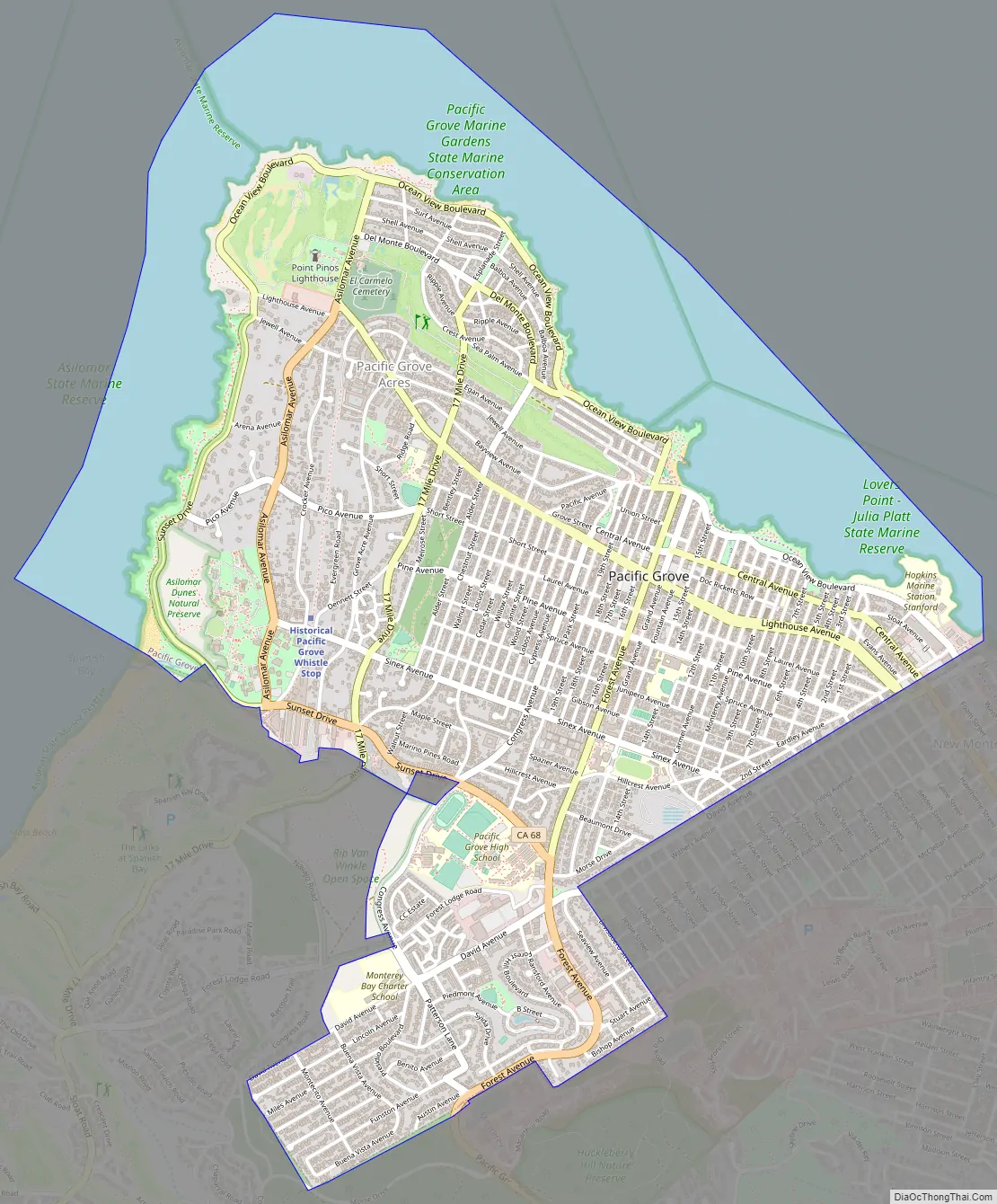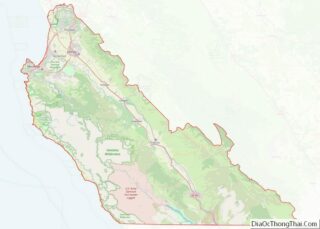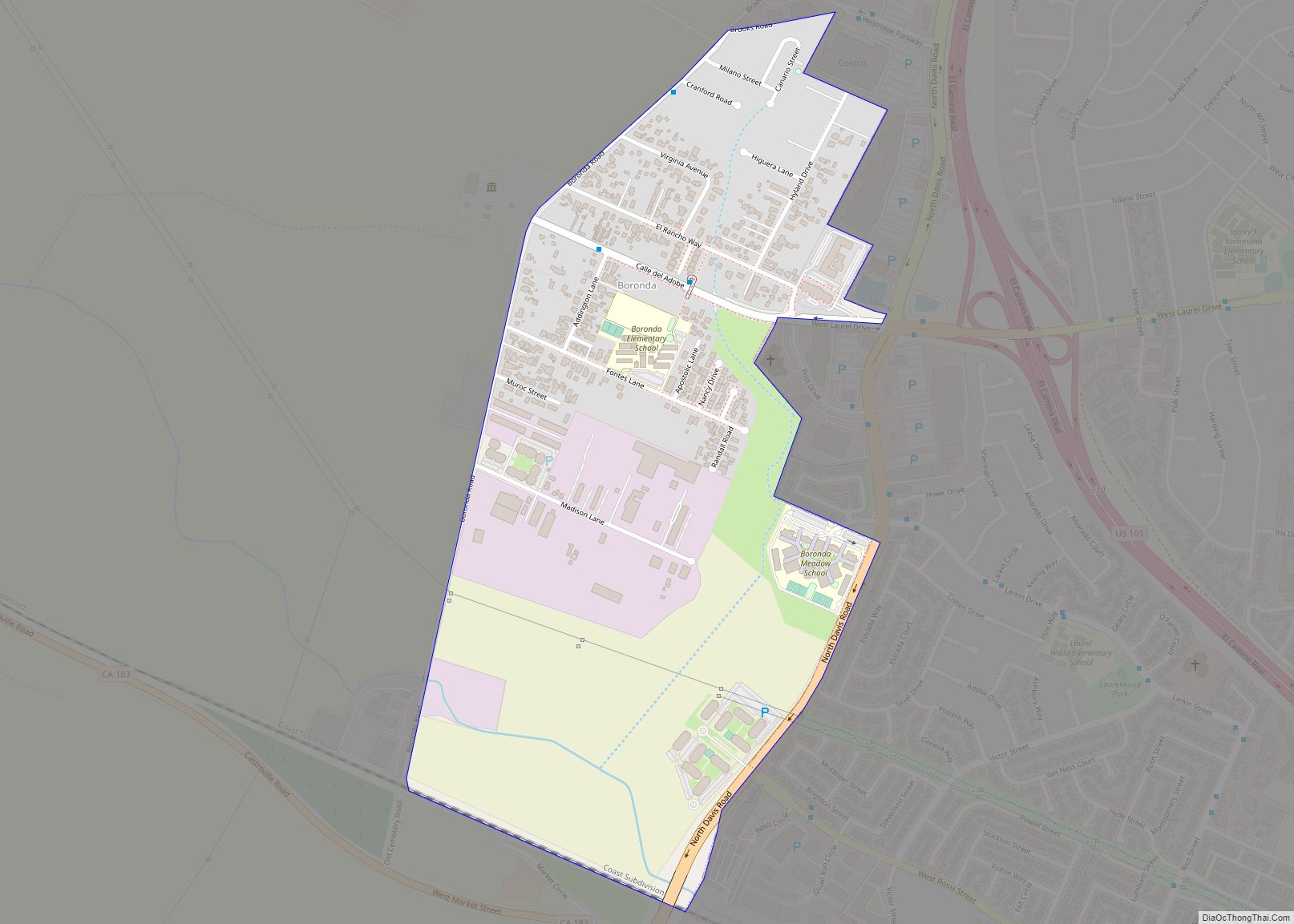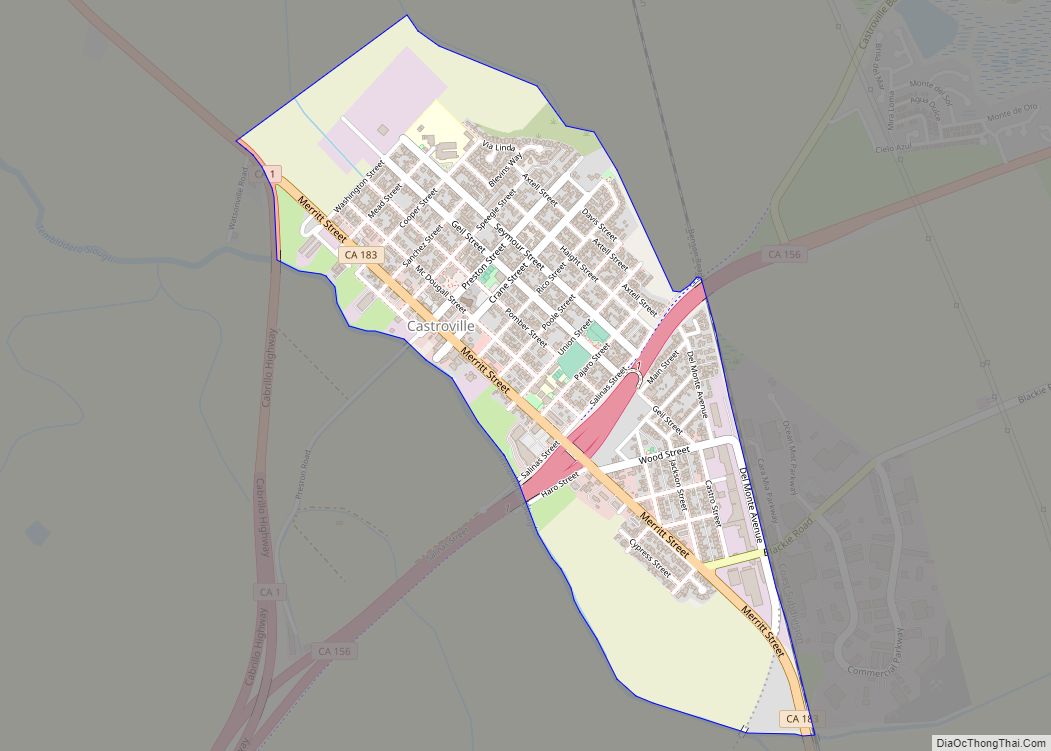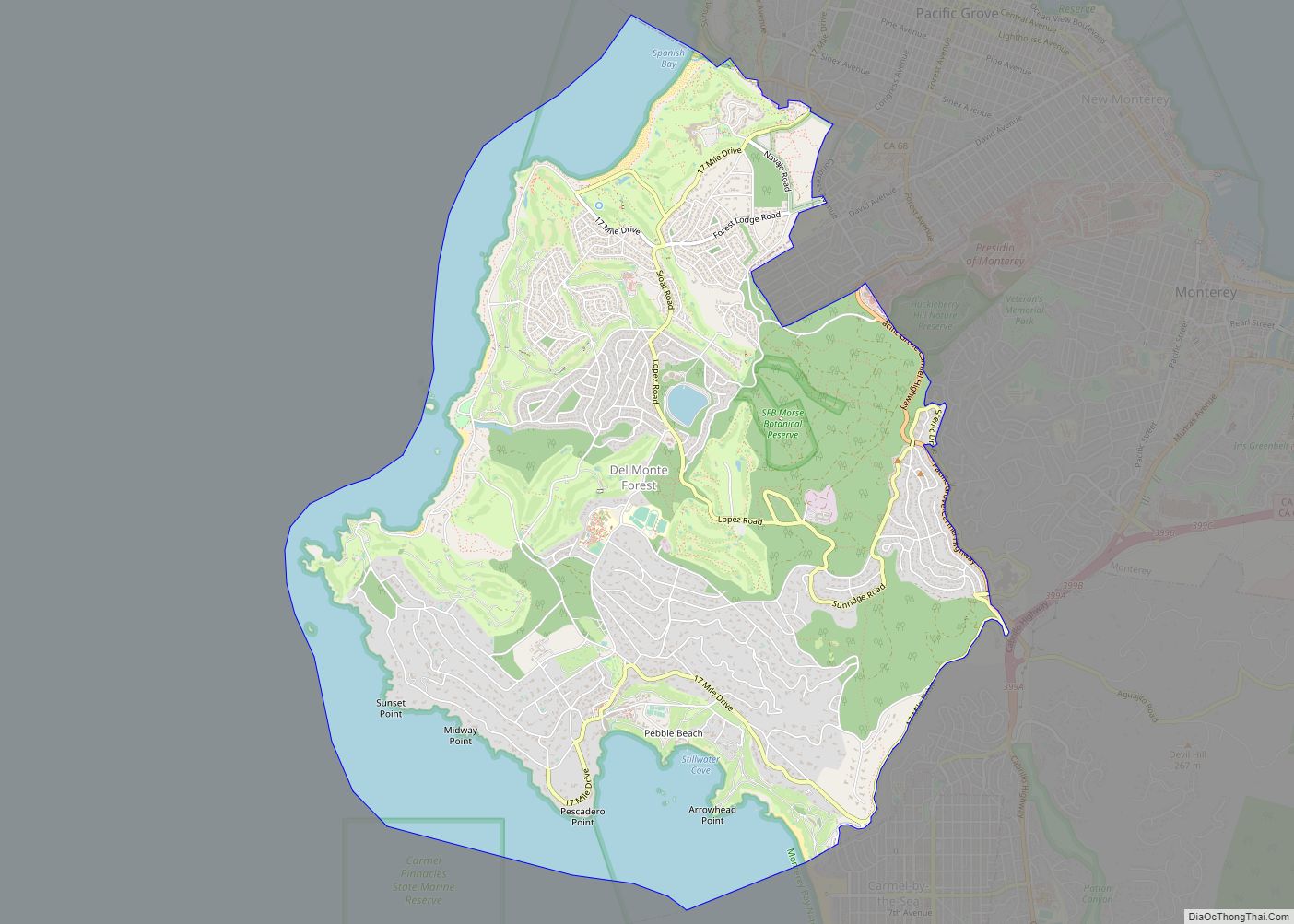Pacific Grove is a coastal city in Monterey County, California, in the United States. The population at the 2020 census was 15,090. Pacific Grove is located between Point Pinos and Monterey.
Pacific Grove has numerous Victorian-era houses, some of which have been turned into bed-and-breakfast inns. The city is the location of the Point Pinos Lighthouse, the Pacific Grove Museum of Natural History and the Asilomar Conference Center. Novelist Robert Louis Stevenson frequented Pacific Grove and wrote of visiting lighthouse-keeper Allen Luce in 1879. Author John Steinbeck resided in Pacific Grove for a number of years. Later, the area was a filming location for A Summer Place starring Sandra Dee, for Roger Spottiswoode’s 1989 film Turner & Hooch, and for the TV series Big Little Lies.
| Name: | Pacific Grove city |
|---|---|
| LSAD Code: | 25 |
| LSAD Description: | city (suffix) |
| State: | California |
| County: | Monterey County |
| Founded: | 1875 |
| Incorporated: | July 5, 1889 |
| Elevation: | 151 ft (46 m) |
| Total Area: | 4.00 sq mi (10.4 km²) |
| Land Area: | 2.87 sq mi (7.4 km²) |
| Water Area: | 1.13 sq mi (2.9 km²) 28.28% |
| Total Population: | 15,090 |
| Population Density: | 5,257.8/sq mi (2,030.0/km²) |
| ZIP code: | 93950 |
| Area code: | 831 |
| FIPS code: | 0654848 |
| Website: | www.cityofpacificgrove.org |
Online Interactive Map
Click on ![]() to view map in "full screen" mode.
to view map in "full screen" mode.
Pacific Grove location map. Where is Pacific Grove city?
History
Pacific Grove was founded in 1875, when David Jacks sold the land to the Pacific Improvement Company, which donated acreage towards the first West Coast Chautauqua retreat formed by a group of Methodists who modeled the town after Ocean Grove, New Jersey. In time, the butterflies, fragrant pines, and fresh sea air brought others to the Pacific Grove Retreat to rest and meditate. The initial camp meeting of the Pacific Coast branch of the Chautauqua Literary and Scientific Circle was held at the Chautauqua Hall in Pacific Grove in June 1879. Modeled after the Methodist Sunday school teachers’ training camp established in 1874 at Chautauqua Lake, New York, this location became part of a nationwide educational network.
In November 1879, after the summer campers returned home, Robert Louis Stevenson wandered into the deserted campgrounds: “I have never been in any place so dreamlike. Indeed, it was not so much like a deserted town as like a scene upon the stage by daylight, and with no one on the boards.”
The Pacific Grove post office opened in 1886, closed later that year, and was reopened in 1887. Pacific Grove incorporated in 1889.
The El Carmelo Hotel was Pacific Grove’s first hotel, opening to guests on May 20, 1887. It was sometimes called the sister of Monterey’s Hotel Del Monte. It was located on Lighthouse Avenue between Fountain and Grand avenues and owned by the Pacific Improvement Company (PIC). In 1907, the name changed to the Pacific Grove Hotel. In 1917, the PIC decided to dismantle it and use the wood in the reconstruction of The Lodge at Pebble Beach that had burned down on December 17, 1917. The empty block was sold to W. R. Holman in 1919 to open the Holman Department Store.
Thomas Albert Work built several of the buildings in Pacific Grove, including the three-story Del Mar hotel in 1895, at the corner of Sixteenth, and in 1904 he built a commercial block along Lighthouse Avenue to house local businesses, including the two-story Romanesque-style Bank of Pacific Grove.
Pacific Grove, like Carmel-by-the-Sea and Monterey, became an artists’ haven in the 1890s and subsequent period. Artists of the En plein air school in both Europe and the United States were seeking an outdoor venue with natural beauty, and Pacific Grove became a magnet for this movement. William Adam was an English painter who first moved to Monterey and then decided on Pacific Grove for his home in 1906. At about the same time, Eugen Neuhaus, a German painter, arrived in Pacific Grove with his new bride. Charles B. Judson was an artist of aristocratic lineage who painted in Pacific Grove over a long time beginning in 1907; Judson’s murals decorate the halls of the California Academy of Sciences in San Francisco.
The Asilomar Conference Grounds are located at the western edge of Pacific Grove. Asilomar opened in 1913 as a YWCA summer retreat; it now belongs to the California State Park System. Thirteen buildings on these grounds were designed by architect Julia Morgan, who also designed Hearst Castle.
For a number of years, John Steinbeck lived in a cottage in Pacific Grove owned by his father, Ernest, who was Monterey County treasurer. The cottage still stands on a quiet side street at 147 11th Street, without any plaque or special sign, virtually overlooked by most Steinbeck fans. Another Steinbeck-related house is at 222 Central Avenue, which was his grandmother’s house. A golden statue of Steinbeck in the front yard stood for years before it was removed. In Steinbeck’s book Sweet Thursday, a chapter is dedicated to describing a (probably fictional) rivalry that arose among the town’s residents over the game of roque.
Local traditions include a Butterfly Parade held in early October to celebrate the return of the monarch butterfly to its wintering habitat. Mid-April, a Good Old Days festival is held downtown, which includes rides, crafts booths, food, entertainment, and a parade. On the last Saturday of July there is a pet parade. Candy Cane Lane is a neighborhood of Morse Dr and Platt Park that is decorated for Christmas each December with an abundance of lights and decorations. Candy Cane Lane has been a local tradition for more than 60 years.
Hopkins Marine Station maintains a campus next to the Monterey Bay Aquarium. It was founded in 1892, making it the oldest marine laboratory on the US Pacific Coast, and the second-oldest in the US, after the Marine Biological Laboratory in Woods Hole, Massachusetts. It was originally named the Hopkins Seaside Laboratory, and is located on what is now Lovers Point.
In the 1980s, Pacific Grove was the site of the pioneering microcomputer software company Digital Research. Originally located in Gary Kildall’s house on the corner of Lighthouse and Willow, it later moved to offices on Central Avenue.
On October 12, 1997, John Denver died when he crashed into the Pacific Ocean off Pacific Grove in his personal plane.
Pacific Grove was the last dry town in California. Due to the city’s religious and gated history, alcohol was not served to the public until July 4, 1969, at the grand opening of the Pacific Grove Art Center by ElMarie Dyke, its founder. This caused much controversy because the law was not to take effect until November of that year. Ironically, ElMarie was also a great proponent for keeping the town dry. To this day, Pacific Grove has very strict laws regarding the service of alcohol and has no stand-alone bars.
Point Alones, which sits on the coast’s edge between Pacific Grove and New Monterey, was the site of a community of Chinese immigrants, who sailed from China to the West Coast around the 1850s, along the coasts of Japan and Russia. Families set up a successful fishing village there, that is documented in the Pacific Grove Museum of Natural History. They would harvest the highly prized abalone from the ocean, drying them to sell in California and export back to China, and would sell the polished shells to passing tourists.
‘The families living in the Chinese Fishing Village were the first to recognize the potential for commercial fishing in the Monterey Bay. Others quickly saw the benefit, however, and eventually pushed the Chinese from their daytime fishing grounds. Being resourceful, they began fishing for squid in the night, thus beginning California’s squid fishery – now on California’s largest fisheries.’
Tourism was growing in the area around the turn of the century – with many new buildings being established, and the Point Alones village becoming an attraction. This is shown in the many postcards produced in this era. The Pacific Grove council notes that the Pacific Improvement Company attempted removal of the Chinese American community in 1905. Now sitting on the land is the Monterey Bay Aquarium.
This site was destroyed by a ‘suspicious’ fire in 1906. ‘The village burned to the ground on May 16, 1906. ‘WHEREAS, on May 17, 1906 local looters picked through warm ashes for Village belongings while that day, and for months after, the Pacific Improvement Company erected fences, posted guards, forcibly removed residents refusing to leave, and tore down rebuilding attempts’
The families, without a village to call their own, soon dispersed throughout the region.’ The loss is memorialised every year in a Walk of Remembrance in mid-May. The walk was created in 2011 by a fifth-generation descendent of the village, Gerry Low-Sabado, who passed away in August 2021.
Pacific Grove City Council voted unanimously in 2022 to revise the government’s telling of events, and named specifically the Pacific Improvement Company as the culprit of the fire. This revision came amidst the Stop Asian Hate movement during the COVID-19 pandemic.
Pacific Grove Road Map
Pacific Grove city Satellite Map
Geography
Pacific Grove contains several habitat types, including marine, littoral, pine forest, and mixed-oak woodland. The famed breeding habitat for the monarch butterfly is situated in the northwest part of town imbedded in residential neighborhoods in mixed oak forests. These monarchs migrate 2,000 miles (3,200 kilometers) to reach Pacific Grove after their summer in the Rocky Mountains, often soaring as high as 3,000 meters (9,800 ft).
The black-and-orange monarch butterflies spend much of the fall and winter in Monterey pine and eucalyptus trees, roughly from the autumnal equinox through the spring (or vernal) equinox. Most butterflies are protected in the city’s Butterfly Sanctuary. City Ordinance No. 352 makes killing or threatening a butterfly a misdemeanor, punishable by a $1,000 fine.
Pacific Grove Marine Gardens State Marine Conservation Area, Lovers Point State Marine Reserve, Edward F. Ricketts State Marine Conservation Area and Asilomar State Marine Reserve are marine protected areas in the waters around Pacific Grove. Like underwater parks, these marine protected areas help conserve ocean wildlife and marine ecosystems. Monterey Bay is a marine protected sanctuary.
The principal noise source in Pacific Grove is State Route 68. There are approximately 800 residents exposed to sound levels of 60 CNEL or above, making Pacific Grove noticeably quieter than its neighbor Monterey, which has more tourist traffic and more through traffic.
The town sits between its two well known neighbors, Pebble Beach and Monterey. Carmel-by-the-Sea is the next city, 5 mi (8 km) south, and the community of Big Sur is 30 mi (50 km) south. Pacific Grove is a favorite vacation getaway for San Francisco Bay Area residents, as it is located two hours south of San Francisco.
The town does not allow development on the waterside of the ocean-front street, so that the beaches and scenic points are unobstructed.
Pacific Grove is on the Pacific Ocean between Monterey and Pebble Beach, about 40 mi (65 km) south of Santa Cruz and about 120 mi (195 km) south of San Francisco. According to the United States Census Bureau, the city has a total area of 4.0 square miles (10 km), and about 2.9 sq mi (7.5 km) are land and 1.1 sq mi (2.8 km) (28.28%) are covered by water. Asilomar, Lovers Point, and the intervening coastline afford surfing, which is challenging due to near-shore rocks, albeit waves are typically moderate in height.
Pacific Grove’s climate is mild throughout the year, essentially the same as in neighboring Monterey, with most of the rain falling from November through April. Extreme temperatures are rare, and fog is common, especially in the late night and early morning, all year.
Climate
This region experiences warm and dry summers, with no average monthly temperatures above 71.6 °F. According to the Köppen climate classification, Pacific Grove has a warm-summer Mediterranean climate, Csb on climate maps.
See also
Map of California State and its subdivision:- Alameda
- Alpine
- Amador
- Butte
- Calaveras
- Colusa
- Contra Costa
- Del Norte
- El Dorado
- Fresno
- Glenn
- Humboldt
- Imperial
- Inyo
- Kern
- Kings
- Lake
- Lassen
- Los Angeles
- Madera
- Marin
- Mariposa
- Mendocino
- Merced
- Modoc
- Mono
- Monterey
- Napa
- Nevada
- Orange
- Placer
- Plumas
- Riverside
- Sacramento
- San Benito
- San Bernardino
- San Diego
- San Francisco
- San Joaquin
- San Luis Obispo
- San Mateo
- Santa Barbara
- Santa Clara
- Santa Cruz
- Shasta
- Sierra
- Siskiyou
- Solano
- Sonoma
- Stanislaus
- Sutter
- Tehama
- Trinity
- Tulare
- Tuolumne
- Ventura
- Yolo
- Yuba
- Alabama
- Alaska
- Arizona
- Arkansas
- California
- Colorado
- Connecticut
- Delaware
- District of Columbia
- Florida
- Georgia
- Hawaii
- Idaho
- Illinois
- Indiana
- Iowa
- Kansas
- Kentucky
- Louisiana
- Maine
- Maryland
- Massachusetts
- Michigan
- Minnesota
- Mississippi
- Missouri
- Montana
- Nebraska
- Nevada
- New Hampshire
- New Jersey
- New Mexico
- New York
- North Carolina
- North Dakota
- Ohio
- Oklahoma
- Oregon
- Pennsylvania
- Rhode Island
- South Carolina
- South Dakota
- Tennessee
- Texas
- Utah
- Vermont
- Virginia
- Washington
- West Virginia
- Wisconsin
- Wyoming


